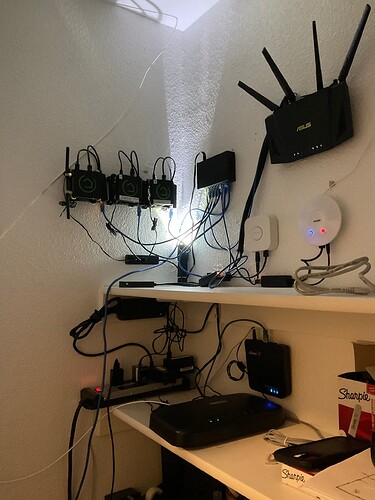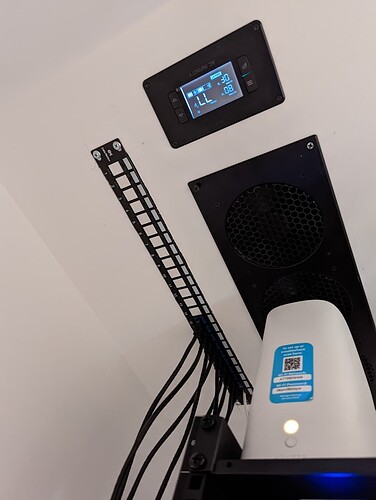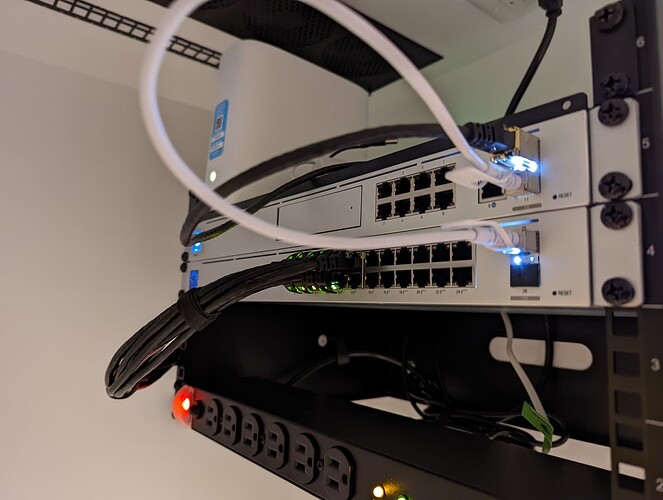All the cable runs are from the outside. One run (to the shed) will be underground,
Yeah -- I read you. I think a lot of it depends on availability and timing. When I looked at Cat6/6a, 7 & 8 in '16/17 when I remodeled, Cat6 ended up being a no-brainer ($), while Cat7 was essentially unobtainium, and as noted used odd connectors, so it became a no go.
It seems like Cat7 cable and Jacks (that uses standard RJ45 connectors) are readily available (although most of my usual sources don't seem to carry nearly as much in the way of 7 products as 8), but even given the cost delta (1000ft of Cat7 can be had for somewhere around $400, while Cat8 is around $6-700), I'd probably lean towards Cat8, as most Cat7 cable I'm seeing is only rated to 600MHz, 10G, while the Cat8 is rated to 2GHz, and 40G.
Fiber would really be the way to go, but I'd still end up pulling a lot of CatX for PoE, so that becomes a non-starter as far as I'm concerned.
But as you pointed out, cost is the real factor here. IF I had to do it again, AND the delta was $200/1000ft, I'd go Cat8, and I probably would stick to Cat6 if I didn't -- there doesn't seem to be enough difference between 6 and 7 to merit the increased cost of 7 over 6.
It's been awhile since I researched this, so it was interesting to do some updating. Pricing has come a long way. Good stuff.
S.
There is currently no Ethernet CONNECTED in the house. Currently, everything runs on wifi, that is what I'm trying to fix. There are three runs of Cat6 in the attic currently. One run has a jack in the family room and runs to the west side of the house but isn't connected to anything. It is just lying there. Estimate that at about 8 feet up to the attic and maybe 75 feet across. I anticipate reutilizing that one. possibly putting a POE switch behind the TV, just for flexibility.
There are two additional runs, and one kind is punched through the outside wall next to the power meter/ fiber connection. those go maybe 8 to 10 feet vertically and run east across the house, estimate maybe 150' one drops down in the wall and is just in the wall in our master bedroom closet behind the old alarm panel (This will eventually be taken out. I plan to at least put a jack on that to utilize it if necessary. The third run is about the same length bt it is just lying there in the attic. I anticipate dropping it through the wall in our master bedroom behind the TV, and similar to the main TV, putting an ethernet switch behind it for flexibility. The run lengths stated above are all estimate, they could be longer or shorter
As for new runs, I am anticipating 3-4 new runs. currently, all of the equipment (modem, router, hubs, etc) is in the closet in my office.
The first new run would be just a few feet up and back down into my office, maybe 20 feet. Two additional runs would be just a few feet up over to my wife's office and the guest bedroom. These could actually drop in the same wall and just put a jack into each room. I anticipate each of these runs to be about 150'. Hopefully, I'm overestimating how much cable I'll be using. I would rather have excess than too little. The last new run would just be about 30 feet up into the attic for potential future use for POE cameras.
Anywhere I have talked about using POE switches I am currently considering something like this though I haven't totally committed to Unifi, so it could end up just being regualrt unmanaged POE switches. If I DO go to ubiquity, there could be an additional run up and maybe 20 feet over to the Unifi WiFi access point,
All runs would be on the interior and would go through roughly the same area in the attic. None of it is in conduit, it is just lying there across the joists. I figure that is most likely what I would do with this new stuff. none of it would be in areas where we would be moving around to change furnace filters or move stuff in and out of storage. For the little bit that might be, I can run that under the plywood so it's not a tripping hazard and would not risk being snagged by someone or something.
Really each run should only have three to four turns. One from the modem/Router to up the wall to the attic, One in the attic to where they are going to be dropped, then one where the jack in the wall is installed.
The other thing I need to figure out is how to bring all this into the closet. Currently, Spectrum just punched a hole in the ceiling and dropped the fiber line through that. I could do that, but it seems sort of hacky. I am not opposed to moving the modem and even the router, but where it currently is is the most central place available. Either way, I think I may need to first have Spectrum come out and move/mount the modem properly, so if I'm going to do that and pay the service call i want to have it remounted in the final and correct place. being fiber, I don't want to take any chances handling that cable and breaking the glass. If I let them do it and they break it they need to fix it.
This is how that closet is currently configured, any suggestions on what to do with this mess are appreciated.
In very general terms, I plan on starting with a 1000' reel, and I think that should be plenty. but I would rather have too much to start and extra if I need to make my own cables for stuff later than to start and have to stop to buy more later.
Can you give that link again? This link is to the same cable you linked to above it.
Be aware, those do not provide their own PoE. You have to provide power via PoE to them and they pass some of the power through to the other port.
I opted for a patch panel in the ceiling (easiest to access without having to run all the cabling into the wall. This included leaving one port open to pass the fiber through (white cable towards the back).
If you have any interest in a rack, now might be the optimal time to bring one into the picture. I was running everything into a smaller closet than you have so I opted to use a wall mounted rack.
I do not totally understand how patch panels work. Isn't that just like X number of connections in to and out of the panel and through the ceiling,same number of holes either way? I'm totally open to them if I understand the concept a bit better.
Unrelated to this project, but in relation to cleaning up the e above, I am in fact interested and willing to consider rack mounted options. seems like all of the ones I am finding are way bigger than I need or have room for.
Well, that depends...how are you planning to pass the cables through the ceiling now? With the patch panel, you'd cut a single hole for the panel to go into. Terminate the cables with keystone jacks and those lock into the pp from the backside. Then you use a patch cable from the panel to your switch.
The upshot is that the panel helps keep things neater as you're dealing with short cables in the closet making them easier to manage. It also means you can just swap patch cable lengths to fit your needs if you move equipment around. It also will help prevent air leakage between that room and whatever is above the ceiling (I sealed mine on the attic side with some silicone).
I'm going on three years with that rack. Like you, I was short on space to put one and didn't need a full stack. I bought a rack shelf to go on top for the ISPs gateway to sit on.
Yup: Amazon.com
S.
I really don’t have a plan now. I guess minimally I was thinking I would need to pass all of those lines down through the ceiling and didn’t really think punching 6 more holes or one larger hole between the attic and the closet was the greatest of ideas. I can wrap my mind around one cable in addition to the fiber cable more easily. I have also considered one of those media cabinets though I haven’t toiled too deeply into it.
So in my situation, with All the new runs (and existing runs) I would run one cable from the router through the ceiling. And the patch panel would actually be in the attic, with those new runs connecting there instead of dropping into the closet?
No. The patch panel is still a 1-1. So, if you have 8 drops, you'd have 8 ports on the patch panel that would need cables to go the rest of the way. You run all your drops to the back of the patch panel. Then you'd install a patch cable from each drop to your switch. The same as if you ran the cables all the way in. The difference is that if you put your gear on the opposite side of the closet, you'd just pick a patch cable that's long enough to reach from the panel to the gear. If you move the gear closer (or farther away) then you'd just have to swap the patch cables for the right length. Makes things very easy to manage and keep clean. Otherwise, you'll have to figure out another way to pop the cables through the ceiling/wall/etc. and hope you left enough slack to reach your gear. If you leave too much then you'll have a mess of cables to deal with.
Depending on your setup and what you want to do the Leviton in-wall media center may be of use.
You know, I actually thought about something like that. Do those mount on the wall? Or do I need to cut the dry wall to mount under the drywall? Are they a standard size to fit between studs?
Structures wiring “cans” are meant to go between 16” center studs with drywall cut. But these have holes in back and could be surface mounted too along one stud.
I have an OnQ branded one under my stairs in an unfinished inner closet. Wires come up from crawl space below.
Yeah, they can certainly be mounted to the wall. I have on in a wall, and one on a wall.
S.
This topic was automatically closed 365 days after the last reply. New replies are no longer allowed.




